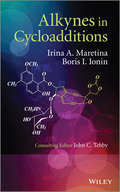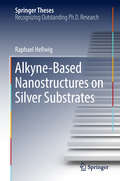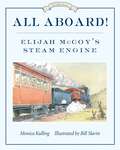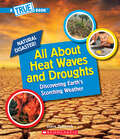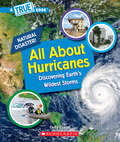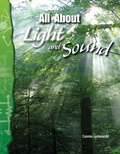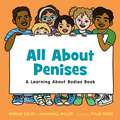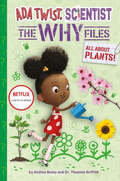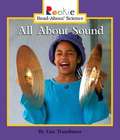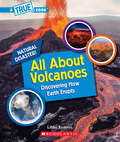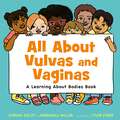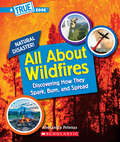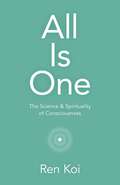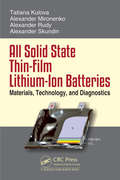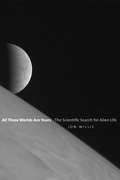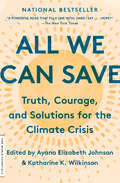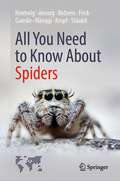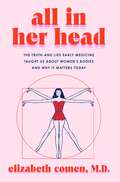- Table View
- List View
Alkynes in Cycloadditions
by Irina A. Maretina John C. Tebby Boris I. IoninAcetylene systems present a new route to cyclic compounds as an alternative to more traditional methods employed in classical organic chemistry. The synthesis of cyclic structures based on acetylene systems has important applications in the formation of nanostructures, naturally occurring compounds and chemosensory materials for the design of nonlinear optics, electronic and photonic devices.Alkynes in Cycloadditions presents a modern review of regioselective synthesis of aromatic and non-aromatic carbocyclic and heterocyclic ring systems based primarily on [2+2+2] and [4+2] cycloadditions, and other reactions of acetylenic units including enediynes and enyne-allenes.Topics covered include:New strategies for the formation of aromatic and polynuclear hydrocarbons based on (Z)-hex-3-en-1,5-diyne and (Z)-hepta-1,2,4-triene-6-yne blocks.One-step synthesis of benzene derivatives, β-substituted naphthalenes and acenes by the cycloaromatization of enediynes and enyne-allenes by Bergman, Myers-Saito and Shmittel.Mechanisms of cycloaromatization resulting in the formation of fulvene and indene systems.Heterocyclization involving enyne-carbodiimides.New achievements in classical cycloaddition reactions such as the Diels-Alder condensation with acetylenic dienophiles and [2+2] cycloadditions with acetylene componentsAlkynes in Cycloadditions presents a comprehensive summary of the literature on methods for the synthesis of ring systems from acetylenes for academic researchers working in the fields of organic synthesis, physical organic chemistry, organometallic chemistry, catalysis, materials science, nanomaterials and biochemistry.
Alkyne‐Based Nanostructures on Silver Substrates (Springer Theses)
by Raphael HellwigAcetylenic precursors are important reactants for creating carbon-based architectures via linkage reactions. While their capability of forming intermolecular bonds is well investigated in solution, very few systematic studies have been carried out to create alkyne-based nanostructures on metal substrates under ultra-high vacuum conditions. Synthesizing extended and regular carbon scaffolds requires a detailed knowledge of alkyne chemistry in order to control reaction pathways and limit unwanted side reactions. Using the bottom-up approach on metal surfaces, the authors establish protocols to fabricate regular architectures built up by the on-surface formation of selective organometallic and C-C bonds with thoughtfully designed alkyne-functionalized monomers. The structural and functional properties of the resulting organometallic and covalent nanostructures are characterized by means of scanning tunneling microscopy. The results open up new perspectives in the fields of heterogeneous catalysis and the on-surface synthesis of functional interfaces under mild reaction conditions.
All Aboard!: Elijah McCoy's Steam Engine (Great Idea Series #2)
by Monica KullingIn the second of Tundra's Great Idea series, biographies for children who are just starting to read, Monica Kulling presents the life of an extraordinary man.There were few opportunities for the son of slaves, but Elijah McCoy's dreams led him to study mechanical engineering in Scotland. He learned everything there was to know about engines - how to design them and how to build them. But when he returned to the United States to look for work at the Michigan Central Railroad, the only job Elijah could get was shoveling coal into a train's firebox.Undaunted, he went on to invent a means of oiling the engine while the train was running, changing the face of travel around the world.With playful text and lively illustrations, All Aboard! Elijah McCoy's Steam Engine may be the first biography a child discovers, and it will whet the appetite for many more.
All About Heat Waves and Droughts (A True Book (Relaunch))
by Steve TomecekConditions on Earth are becoming more and more extreme and kids want to learn about it! Is it true that heat waves can make roads break apart? Yes! When it’s extra hot, the materials that roads are made of will swell and start to crack.INSIDE, YOU´LL FIND:• How heat waves and droughts happen, why they happen, and an account of the most devastating ones in recent history;• A hands-on activity, a timeline, photos, diagrams—and what you can do if a heat wave or drought happens;• Surprising TRUE facts that will shock and amaze you!This new set in the ongoing A TRUE BOOK series will answer all of kids' questions about nature's most dangerous and destructive disasters! With an engaging layout, and spectacular photos, illustrations, diagrams and infographics, the past, present and future of extreme phenomenon happening on Earth will be explained. Readers will discover causes and consequences, as well as the cutting-edge science developed through the centuries to forecast them. First-hand accounts will bring science to life, and a special section will teach kids how to prepare for these extreme events.
All About Hurricanes (A True Book (Relaunch))
by Cody CraneConditions on Earth are becoming more and more extreme and kids want to learn about it! Is it true that hurricanes can be seen from space? Yes! Weather satellites track hurricanes. Pictures from these satellites tell where a hurricane is going and how big and fast it is.INSIDE, YOU´LL FIND:• How hurricanes form, how fast they move, and an account of the most dangerous hurricanes in recent history;• A hands-on activity, a timeline, photos, diagrams—and how meteorologists study hurricanes to keep people safe;• Surprising TRUE facts that will shock and amaze you!This new set in the ongoing A TRUE BOOK series will answer all of kids' questions about nature's most dangerous and destructive disasters! With an engaging layout, and spectacular photos, illustrations, diagrams and infographics, the past, present and future of extreme phenomenon happening on Earth will be explained. Readers will discover causes and consequences, as well as the cutting-edge science developed through the centuries to forecast them. First-hand accounts will bring science to life, and a special section will teach kids how to prepare for these extreme events.
All About Light And Sound
by Connie JankowskiLight and sound are two of the most important ways to understand the world around us. The sun is Earth's main source of energy and light. Light bounces off objects and travels to our eyes. Our eyes and brain work together to translate that light into what we see while our ears pick up sound vibrations and translate them into meaningful messages.
All About Penises: A Learning About Bodies Book
by Dorian Solot Marshall MillerHead, shoulders, knees, and . . . penises! Young children are curious about all body parts.With bright illustrations, readable language, and a matter-of-fact tone, this guide offers readers the information they need to understand how bodies work.All About Penises is a book that embraces body diversity, reassures kids, and provides caregivers easy ways to answer the common questions that children have. Additional guidance for parents and caregivers includes more information on being an askable parent and how to talk to young children about sensitive topics.
All About Plants! (Questioneers)
by David Roberts Andrea Beaty Theanne GriffithAll About Plants (Ada Twist, Scientist: The Why Files) is the second book in a nonfiction early reader series based on the Netflix show from New York Times bestselling creator of the Questioneers, Andrea Beaty, and author Theanne Griffith. <P><P> What do plants eat? Why do some plants have flowers and others don’t? And what’s the tallest plant out there? Ada Twist, Scientist: The Why Files is the perfect nonfiction resource for all these questions and more. Based on the bestselling series and the Netflix show, this nonfiction series is perfect for the youngest scientists of tomorrow as they learn along with Ada. Designed in a scrapbook format, these books combine art from the show, illustrations, and photography to bring simple science concepts to life.
All About Rocks and Minerals: An Introduction for Kids
by Lisa TrusianiDig in to a fun first look at rocks and gems for kids ages 3 and up From tiny pebbles to huge mountains, rocks are everywhere! And young rockhounds can explore them with All About Rocks and Minerals. It's packed full of fascinating facts and photos that introduce kids to 50 impressive stones. They'll discover what each one looks like, what makes it unique, and more.The life of a rock—Start with a brief introduction that explains how rocks are formed, the 3 types of rock, and the difference between rocks, minerals, and crystals.Big, beautiful images—Colorful pictures let kids get up close and personal with all kinds of awesome rocks and gems.Amazing rock facts—Did you know that there's a special stone for the month you were born? Or that sailors believed aquamarine would protect them at sea?Give curious kids an exciting introduction to geology with this rocks and minerals book for kids.
All About Seeds
by Melvin BergerWhat are seeds? Where do they come from? What do they need to grow into plants? In this book you will learn All About Seeds by collecting, planting, and cooking them.
All About Sound (Rookie Read About® Science)
by Lisa TrumbauerThis Rookie Read-About® Science book introduces young readers to the world of sound. Colorful photos and simple text encourage children to read on their own as they explore the many different kinds of sounds and how they are made, felt, and heard.
All About Tornadoes: Discovering Earth's Strongest Winds A True Book Natural Disasters (A True Book (Relaunch))
by Cody CraneConditions on Earth are becoming more and more extreme and kids want to learn about it! Is it true that tornadoes have the strongest winds on Earth? Yes! Their winds can reach 300 miles per hour (483 kph), sweeping up anything in their paths. They can toss cars and trees through the air and even level entire towns.INSIDE, YOU´LL FIND:• How tornadoes form, how they spin, and an account of the most dangerous tornadoes in recent history;• A hands-on activity, a timeline, photos, diagrams—and how meteorologists study tornadoes to keep people safe;• Surprising TRUE facts that will shock and amaze you!This new set in the ongoing A TRUE BOOK series will answer all of kids' questions about nature's most dangerous and destructive disasters! With an engaging layout, and spectacular photos, illustrations, diagrams and infographics, the past, present and future of extreme phenomenon happening on Earth will be explained. Readers will discover causes and consequences, as well as the cutting-edge science developed through the centuries to forecast them. First-hand accounts will bring science to life, and a special section will teach kids how to prepare for these extreme events.
All About Volcanoes (A True Book (Relaunch))
by Libby RomeroConditions on Earth are becoming more and more extreme and kids want to learn about it! Is it true that, at any given time, about 20 volcanoes are erupting somewhere on Earth? Yes! Sometimes volcanoes erupt with a big, dangerous bang. Other times they spit out lava so slowly that you could walk faster than it flows.INSIDE, YOU´LL FIND:• How volcanoes form, when they erupt, and an account of the most devastating ones in recent history;• A hands-on activity, a timeline, photos, diagrams—and how scientists are studying volcanoes and their impact on our planet;• Surprising TRUE facts that will shock and amaze you!This new set in the ongoing A TRUE BOOK series will answer all of kids' questions about nature's most dangerous and destructive disasters! With an engaging layout, and spectacular photos, illustrations, diagrams and infographics, the past, present and future of extreme phenomenon happening on Earth will be explained. Readers will discover causes and consequences, as well as the cutting-edge science developed through the centuries to forecast them. First-hand accounts will bring science to life, and a special section will teach kids how to prepare for these extreme events.
All About Vulvas and Vaginas: A Learning About Bodies Book
by Dorian Solot Marshall Miller"Educational and approachable" – Publishers Weekly Head, shoulders, knees, and . . . vulvas and vaginas! Young children are curious about all body parts.With bright illustrations, readable language, and a matter-of-fact tone, this guide offers readers the information they need to understand how bodies work.All About Vulvas and Vaginas is a book that embraces body diversity, reassures kids, and provides caregivers easy ways to answer the common questions that children have.Additional guidance for parents and caregivers includes more information on being an askable parent and how to talk to young children about sensitive topics.
All About Wildfires: Discovering How They Spark, Burn And Spread A True Book Natural Disasters (A True Book (Relaunch))
by Alessandra PotenzaConditions on Earth are becoming more and more extreme and kids want to learn about it! Is it true that smoke from wildfires can travel thousands of miles? Yes! If a wildfire is large enough, wind can blow smoke from the West Coast to the East Coast of the United States!INSIDE, YOU´LL FIND:• How wildfires start, how they spread, and how researchers are studying wildfires in order to keep people safe;• A hands-on activity, a timeline, photos, diagrams—and how specially-trained firefighters fight the flames;• Surprising TRUE facts that will shock and amaze you!This new set in the ongoing A TRUE BOOK series will answer all of kids' questions about nature's most dangerous and destructive disasters! With an engaging layout, and spectacular photos, illustrations, diagrams and infographics, the past, present and future of extreme phenomenon happening on Earth will be explained. Readers will discover causes and consequences, as well as the cutting-edge science developed through the centuries to forecast them. First-hand accounts will bring science to life, and a special section will teach kids how to prepare for these extreme events.
All Flesh Is Grass: Plant-Animal Interrelationships (Cellular Origin, Life in Extreme Habitats and Astrobiology #16)
by Joseph Seckbach Zvy DubinskyThis new book takes us through a journey from early life to modern agriculture. The thirty eight authors present current studies on the interrelation of plants-animals. This topic has always fascinated man, as evidenced even by the first chapters of Genesis. The world of aqueous and terrestrial fauna appeared on early earth only after the flora covered the areas with the green pigmentation. Almost all life depends upon sunlight via the photosynthesis of the botanical world. We read abut the harnessing of bee pollination of crops to make it an essential component of modern agriculture endeavor. Some plants seduce insects for pollination by their appearance (e.g., disguised orchids entice visitors); there is the production of sweet nectar as a bribe in flowers to attract bees, butterflies, and honey-sucking birds. A particular outstanding phenomena are the carnivorous plants that have developed trapping and digesting systems of insects and higher animals.
All Is One: The Science & Spirituality of Consciousness
by Ren Koi'WOW, what a great book. As a person who has been in the world of recovery for 30+ years, it goes straight to the heart of the &“missing piece&” for most alcoholics and addicts.' Dr Robb Kelly, The Addiction DoctorDespite centuries of analyses and debates between scientists and philosophers, consciousness remains puzzling and controversial. It is the most familiar yet mysterious aspect of our lives. There might be different levels of consciousness, or different kinds of consciousness, or just one kind with different features. Modern research into the human brain is yet to provide conclusive answers, and we don't know if animals, insects or plants are conscious, or even the universe itself. The contrasting range of research suggests that a new approach might be needed \-\- one that includes both an objective scientific view and a subjective philosophical and spiritual view \-\- in order to unlock the mystery. All Is One investigates how consciousness fits into a larger picture of the universe by exploring what science, philosophy, religion, and spirituality have to say on the matter, and offers a conclusive definition of consciousness that might satisfy both the scientifically oriented and spiritually oriented reader.
All Night Long
by Betsy JamesNick, the night zookeeper, has an important job: to care for all the animals while everyone else sleeps. Follow him along while he performs his nightly duties at the zoo.
All Solid State Thin-Film Lithium-Ion Batteries: Materials, Technology, and Diagnostics
by Alexander Skundin Tatiana Kulova Alexander Rudy Alexander MiromemkoA comprehensive, accessible introduction to modern all-solid-state lithium-ion batteries. All-solid-state thin-film lithium-ion batteries present a special and especially important version of lithium-ion ones. They are intended for battery-powered integrated circuit cards (smart-cards), radio-frequency identifier (RFID) tags, smart watches, implantable medical devices, remote microsensors and transmitters, Internet of Things systems, and various other wireless devices including smart building control and so on. Comprising four chapters the monograph explores and provides: The fundamentals of rechargeable batteries, comparison of lithium-ion batteries with other kinds, features of thin-film batteries. A description of functional materials for all-solid-state thin-film batteries. Various methods for applying functional layers of an all-solid-state thin-film lithium-ion battery. Diagnostics of functional layers of all-solid-state thin-film lithium-ion batteries. The monograph is intended for teachers, researchers, advanced undergraduate students, and post-graduate students of profile faculties of universities, as well as for developers and manufacturers of thin-film lithium-ion batteries.
All That the Rain Promises and More: A Hip Pocket Guide to Western Mushrooms
by David Arora&“[All That the Rain Promises and More] is certainly the best guide to fungi, and may in fact be a long lasting masterpiece in guide writing for all subjects.&”—Roger McKnight, The New York TimesMushrooms appeal to all kinds of people—and so will this handy pocket guide, which includes key information for more than 200 Western mushroomsOver 200 edible and poisonous mushrooms are depicted with simple checklists of their identifying features, as David Arora celebrates the fun in fungi with the same engaging bend of wit and wisdom, fact and fancy, that has made his comprehensive guide, Mushrooms Demystified, the mushroom hunter&’s bible.&“The best guide for the beginner. I&’d buy it no matter where I lived in North America.&”—Whole Earth Catalog
All These Worlds Are Yours: The Scientific Search for Alien Life
by Jon WillisAn astronomer explores the science of astrobiology in this &“serious but accessible examination of the prospects for finding life elsewhere in the universe&” (Sean Carroll, author of The Big Picture). Describing the most recent discoveries made with space exploration technology, including the Kepler space telescope, the Mars Curiosity rover, and the New Horizons probe, astronomer Jon Willis asks readers to consider five possible scenarios for finding extraterrestrial life. He reviews what we know and don&’t know about the life-sustaining potential of Mars&’s subsoil ice and the water-ice moons Europa and Enceladus. He also looks at Saturn&’s moon Titan through the lens of our own planet&’s ancient past. In this concise yet far-reaching volume, Willis even looks beyond our solar system, investigating the top candidates for a &“second Earth&” in a myriad of exoplanets. &“Through humorous, concise, accessible writing, Willis eloquently presents the growing—though still circumstantial—evidence that we are not alone."—Publishers Weekly (starred review)
All We Can Save: Truth, Courage, and Solutions for the Climate Crisis
by Ayana Elizabeth Johnson Katharine K. WilkinsonProvocative and illuminating essays from women at the forefront of the climate movement who are harnessing truth, courage, and solutions to lead humanity forward. There is a renaissance blooming in the climate movement: leadership that is more characteristically feminine and more faithfully feminist, rooted in compassion, connection, creativity, and collaboration. While it&’s clear that women and girls are vital voices and agents of change for this planet, they are too often missing from the proverbial table. More than a problem of bias, it&’s a dynamic that sets us up for failure. To change everything, we need everyone. All We Can Save illuminates the expertise and insights of dozens of diverse women leading on climate in the United States—scientists, journalists, farmers, lawyers, teachers, activists, innovators, wonks, and designers, across generations, geographies, and race—and aims to advance a more representative, nuanced, and solution-oriented public conversation on the climate crisis. These women offer a spectrum of ideas and insights for how we can rapidly, radically reshape society. Intermixing essays with poetry and art, this book is both a balm and a guide for knowing and holding what has been done to the world, while bolstering our resolve never to give up on one another or our collective future. We must summon truth, courage, and solutions to turn away from the brink and toward life-giving possibility. Curated by two climate leaders, the book is a collection and celebration of visionaries who are leading us on a path toward all we can save. With essays and poems by:Emily Atkin • Xiye Bastida • Ellen Bass • Colette Pichon Battle • Jainey K. Bavishi • Janine Benyus • adrienne maree brown • Régine Clément • Abigail Dillen • Camille T. Dungy • Rhiana Gunn-Wright • Joy Harjo • Katharine Hayhoe • Mary Annaïse Heglar • Jane Hirshfield • Mary Anne Hitt • Ailish Hopper • Tara Houska, Zhaabowekwe • Emily N. Johnston • Joan Naviyuk Kane • Naomi Klein • Kate Knuth • Ada Limón • Louise Maher-Johnson • Kate Marvel • Gina McCarthy • Anne Haven McDonnell • Sarah Miller • Sherri Mitchell, Weh&’na Ha&’mu Kwasset • Susanne C. Moser • Lynna Odel • Sharon Olds • Mary Oliver • Kate Orff • Jacqui Patterson • Leah Penniman • Catherine Pierce • Marge Piercy • Kendra Pierre-Louis • Varshini • Prakash • Janisse Ray • Christine E. Nieves Rodriguez • Favianna Rodriguez • Cameron Russell • Ash Sanders • Judith D. Schwartz • Patricia Smith • Emily Stengel • Sarah Stillman • Leah Cardamore Stokes • Amanda Sturgeon • Maggie Thomas • Heather McTeer Toney • Alexandria Villaseñor • Alice Walker • Amy Westervelt • Jane Zelikova
All You Need to Know About Spiders
by Wolfgang Nentwig Jutta Ansorg Angelo Bolzern Holger Frick Anne-Sarah Ganske Ambros Hänggi Christian Kropf Anna StäubliAll You Need to Know About SpidersSpiders are super predators and devour everything they can overpower. To do this, they have developed incredibly good catching techniques and, with spider silk, a tool that makes material technology green with envy. The males are usually smaller than the females and, in order to have sex, they have to come up with a lot to avoid being misunderstood as easy prey: Dancing, drumming, and gifts almost always help. Spiders use their venom in very precise doses, and since humans are not on their menu, they are harmless to us. Many people's (unnecessary) fear of spiders finds cultural roots as early as the Middle Ages. Nevertheless, spider fear is easily treatable. There is no habitat or building without spiders. And that's a good thing, because spiders have fascinating properties and their world is full of surprises. Everything you need to know about them is explained in this book in understandable language by experts for laymen. In addition, some of the most common spider species in the house and garden are briefly presented with tips for observation. The authorsThis book is authored by eight scientists, all of them members of the Association for the Promotion of Spider Research: Wolfgang Nentwig, Jutta Ansorg, Angelo Bolzern, Holger Frick, Anne-Sarah Ganske, Ambros Hänggi, Christin Kropf und Anna Stäubli
All You Need to Know About the Next Energy Revolution: Solutions for a Truly Sustainable Future
by Erwan Saouter Thomas GibonClimate change is a reality that cannot now be disputed and solutions exist, whether technological or societal. However, it is essential to understand their capacity to meet a demand for energy and resources that will continue to grow. Faced with the confusion of messages, the multiplicity, and, sometimes, the naivety of the roadmaps for achieving a carbon-neutral world, this concise book proposes a return to the fundamentals that we should all know before we can choose the type of development we want. It invites us to move away from dogmatic positions, preconceived, and partisan ideas and to become aware that all the choices available to us have advantages and disadvantages, and that these must be rigorously quantified in order to prevent today's solutions from becoming tomorrow's disasters.
All in Her Head: The Truth and Lies Early Medicine Taught Us About Women's Bodies and Why It Matters Today
by Elizabeth ComenFinalist for the 2025 PEN/E.O. Wilson Literary Science Writing AwardUSA Today Bestseller“All in Her Head accomplishes a remarkable feat of storytelling. By combining essential medical histories about women’s bodies with all the narrative propulsion of a medical thriller, Comen has written a must-read, compelling, and important book.”—Siddhartha Mukherjee, Pulitzer Prize–winning author of The Emperor of All Maladies and The Song of the Cell“Wow! This book will upend everything you thought you knew about your body while empowering you to make better decisions moving forward. Through storytelling, extensive research, and easy recommendations, Dr. Elizabeth Comen has given us all a priceless road map to reclaim our agency.”—Eve Rodsky, author of Fair PlayA surprising, groundbreaking, and fiercely entertaining medical history that is both a collective narrative of women’s bodies and a call to action for a new conversation around women’s health.For as long as medicine has been a practice, women's bodies have been treated like objects to be practiced on: examined and ignored, idealized and sexualized, shamed, subjugated, mutilated, and dismissed. The history of women’s healthcare is a story in which women themselves have too often been voiceless—a narrative instead written from the perspective of men who styled themselves as authorities on the female of the species, yet uninformed by women’s own voices, thoughts, fears, pain and experiences. The result is a cultural and societal legacy that continues to shape the (mis)treatment and care of women.While the modern age has seen significant advancements in the medical field, the notion that female bodies are flawed inversions of the male ideal lingers on—as do the pervasive societal stigmas and lingering ignorance that shape women’s health and relationships with their own bodies.Memorial Sloan Kettering oncologist and medical historian Dr. Elizabeth Comen draws back the curtain on the collective medical history of women to reintroduce us to our whole bodies—how they work, the actual doctors and patients whose perspectives and experiences laid the foundation for today’s medical thought, and the many oversights that still remain unaddressed. With a physician’s knowledge and empathy, Dr. Comen follows the road map of the eleven organ systems to share unique and untold stories, drawing upon medical texts and journals, interviews with expert physicians, as well as her own experience treating thousands of women.Empowering women to better understand ourselves and advocate for care that prioritizes healthy and joyful lives— for us and generations to come—All in Her Head is written with humor, wisdom, and deep scientific and cultural insight. Eye-opening, sometimes enraging, yet always captivating, this shared memoir of women’s medical history is an essential contribution to a holistic understanding and much-needed reclaiming of women’s history and bodies.
